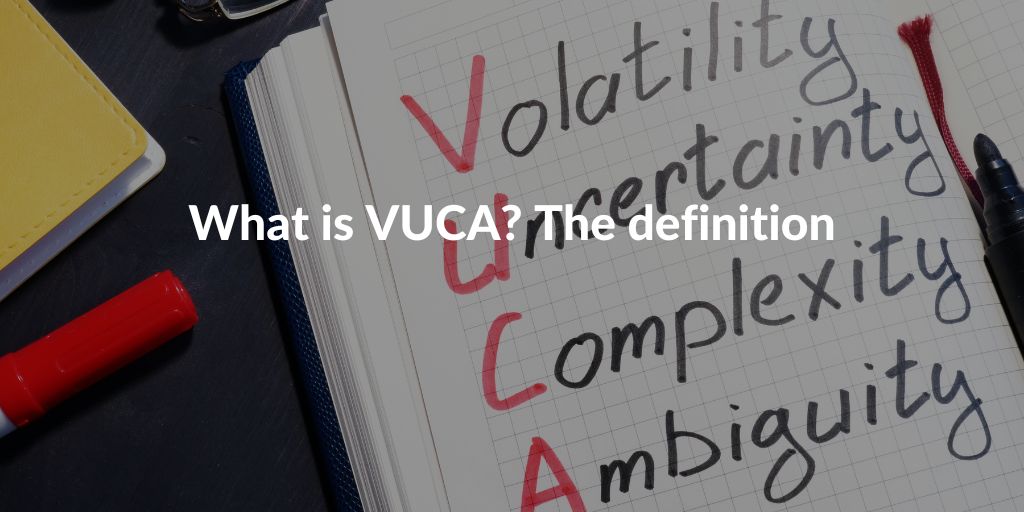What is meant by the term VUCA? Why is it linked to the world of project management and in what way? This blogpost covers the meaning, the definition and the characteristics.
What is the VUCA Model
The acronym VUCA stands for volatility, uncertainty, complexity and ambiguity. The VUCA model seeks to describe the changes in today’s world. Our modern world is becoming increasingly complex due to globalisation and digitalisation. This is evident in globalised markets and financial flows, which have become almost impenetrable.
With rapidly changing markets, it is becoming increasingly difficult to plan, to analyse different situations.
Today’s leaders must be able to mitigate these difficulties in order to improve their strategic capabilities and achieve better results. To do this, it is necessary for companies, leaders and even project managers to react in an Agile way to the VUCA model.
Some examples of the constant changes to be faced are new work, the home office or the 4-day week. But also megatrends such as digitisation or globalisation. This all results in more complex processes and projects and increased uncertainties.
In this rapidly changing world, it is often difficult for a company to adapt and survive. All these changes are part of what is called VUCA.
The VUCA model can be used to analyse what you know and what you don’t know about a situation or a plan and thus better understand what the vulnerabilities and risks are. With the VUCA model, leaders can better manage the changing business landscape.
VUCA Definition origin
The acronym VUCA was first used in 1987 at the U.S. Army War College and was published in 1991 by Herbert Barber. The method was developed based on the concepts presented by Warren Bennis and Burt Nanus in their book Leaders: The Strategies for Taking Charge. VUCA was applied to conditions after the end of the Cold War and the conflict in Afghanistan at that time.
The term VUCA can be applied to a situation in general. It is sometimes used derogatorily to ignore the value of planning.
V for volatility
The V in VUCA stands for volatility, i.e. being subject to frequent, rapid and significant changes.
These are all those small triggers that can cause big changes.
To cope with volatility and adapt to change, project managers and leaders have only one alternative: to lead teams in an agile way.
U for uncertainty
The U in VUCA stands for uncertainty.
The latter occurs when events and outcomes are unpredictable Without a solid base, it will be difficult to plan investments, e.g. for development and growth. Or one will not know whether and how much a price may go up or down.
C for complexity
The third factor is that of complexity.
In today’s world everything is increasingly complex, precisely because problems and consequences are layered and difficult to solve. Also the possibility of having a clear overview is complex.
A for ambiguity
The last characteristic of the VUCA world is ambiguity.
This term also encapsulates the previous ones. In fact, it can be attributed to the various situations mentioned above, i.e. uncertainty and difficulty in being able to divide black and white things clearly.
Lack of clarity can lead to misinterpretation of information. The objective or desired outcome may not be obvious to all parties involved. In an ambiguous market, for example, not all information is public and invisible factors may influence prices.
How to use the VUCA model
In this wide range of situations that seem to be exclusively adverse, it is also necessary to see the positive side, the fact that there are many more possibilities, the continuous transformation and the exchange of information on a digital level allow for a growth of interconnections between individuals.
VUCA can have new meanings: Vision, Understanding, Clarity, Agility.
In companies, VUCA manifests itself through innovative business models, often driven by new technologies. Completely new possibilities and business models also emerge that are not disruptive or substitutive.
Programmes often find themselves in a VUCA environment. Acknowledging this helps organisations to be able to respond and support their programmes to gain benefits.
So how can you use the VUCA model for better results?
- starting from the expected result, proceeding backwards by identifying opportunities and advantages
- simplifying processes
- focusing on what really matters
- transforming fear and resistance arising from change into productive energy
favouring clarity and simplicity, creating transparent processes.
Understanding and applying the VUCA model can help you to shape the future. The model can support with the usage of available means, collaborating with the right people, taking risks, remaining flexible and open to change and thus taking advantage of all the new opportunities that arise.
This is the only way to overcome the challenges facing us in the VUCA world. This requires an effort of freedom, creativity, speed, flexibility and a corporate culture that connects resources with the organisation.








